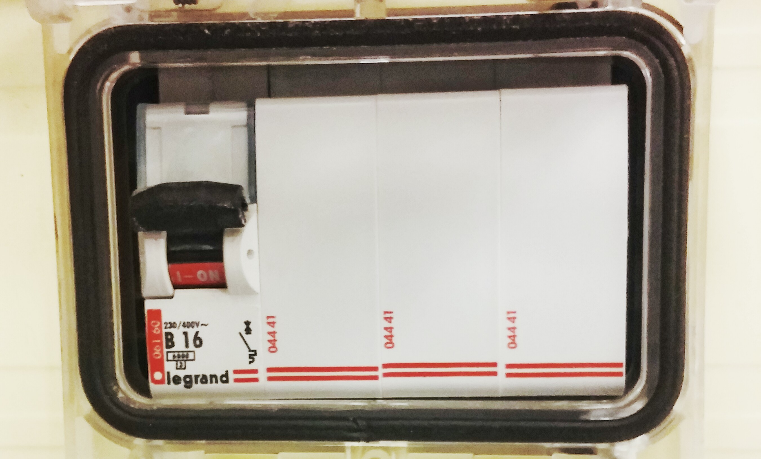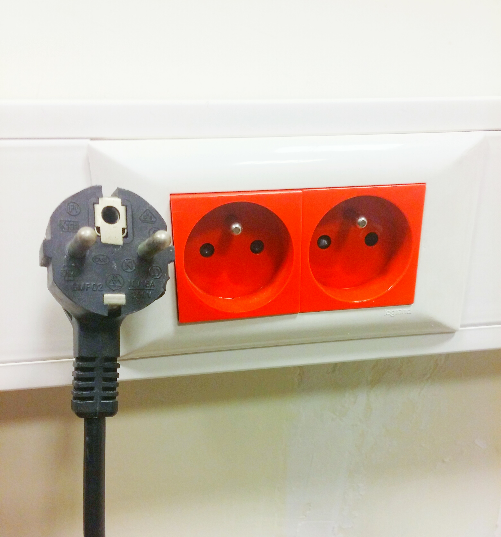Common Electrical Hazards and Preventable Steps
The major hazards associated with electricity are electrical shock and fire. Electrical shock occurs when the body becomes part of the electric circuit, either when an individual comes in contact with both wires of an electrical circuit, one wire of an energized circuit and the ground, or a metallic part that has become energized by contact with an electrical conductor.
The severity and effects of an electrical shock depend on a number of factors, such as the pathway through the body, the amount of current, the length of time of the exposure, and whether the skin is wet or dry. Water is a great conductor of electricity, allowing current to flow more easily in wet conditions and through wet skin. The effect of the shock may range from a slight tingle to severe burns to cardiac arrest. Table 10.1 shows the general relationship between the degree of injury and amount of current for a 60-cycle hand-to-foot path of one second's duration of shock. While reading this chart, keep in mind that most electrical circuits can provide, under normal conditions, up to 20,000 milliamperes of current flow.
| Table 10.1 Body Reactions Under Effect of Electrical Current | |
| Current | Reaction |
| 1 Milliampere | Perception level |
| 5 Milliamperes | Slight shock felt; not painful but disturbing |
| 6-30 Milliamperes | Painful shock; "let-go" range |
| 50-150 Milliamperes | Extreme pain, respiratory arrest, severe muscular contraction |
| 1000-4,300 Milliamperes | Ventricular fibrillation |
| 10,000+ Milliamperes | Cardiac arrest, severe burns and probable death |
Adopted from Princeton University Environmental Health and Safety Handbook
In addition to the electrical shock hazards, sparks from electrical equipment can serve as an ignition source for flammable or explosive vapors or combustible materials.
Loss of electrical power can create hazardous situations. Flammable or toxic vapors may be released as a chemical warms when a refrigerator or freezer fails. Fume hoods may cease to operate, allowing vapors to be released into the laboratory. If magnetic or mechanical stirrers fail to operate, safe mixing of reagents may be compromised.
Electric shock
Electric shock is another hazard common to many pieces of laboratory equipment. Any electrically powered item of laboratory equipment which is subject to spillage of chemicals or water, or exhibit signs of excessive wear should be used carefully.
Electrical shocks occur when the electrical circuit completed by the part of human body. One way this can occur is by contacting a metallic part of a piece of equipment that has become energized by contact with an electrical conductor. The severity of the electrical shock depends on the following:
- The amount of the current (given as a list above)
- The pathway through the body
- The duration of the exposure
- Whether the skin is wet or dry
A victim of electrical shock could be knocked unconscious. If the victim is still in contact with the live power source, turn off the live source or press the emergency power cut off button before administering aid. Do not touch anyone that is still in contact with a live power source, as you could be electrocuted as well
After disconnecting power, administer first aid and/or call Health Center (7666).
Resistive heating
Even if an individual survives a shock episode, there may be immediate and long-term harm on tissue, nerves, and muscle due to heat generated by the current flowing through the body. The heat generated is basically resistive heating such as would be generated in heating coils in a small space heater.
The scope of the effects of external electrical burns is usually immediately apparent, but the total effect of internal burns may become manifest later on by losses of important body functions due to the destruction of critical internal organs, including portions of the nervous system, which is especially vulnerable.
If a victim has resistive heating burns; you should apply “Burn Kit”, then call Health Center (7666).
Spark ignition sources
Induction motors should be used in most laboratory applications instead of series-wound electric motors, which generate sparks from the contacts of the carbon brushes. It is vital to use non-sparking motors in pieces of equipment which result in considerable amounts of vapour, such as blenders, evaporators, or stirrers. Equivalent ordinary equipment or other items such as vacuum cleaners, drills, rotary saws, or other power equipment are not suitable for use in laboratories where solvents are in use. Blowers used in fume exhaust systems should at least have non-sparking fan blades, but in critical situations with easily ignitable vapors being exhausted, it may be worth the additional cost of a fully explosion-proof blower unit.
Any device in which an electrically live circuit makes and breaks, as in a thermostat, an on-off switch, or other control mechanism, is a potential source of ignition for flammable gases or vapors. Special care should be taken to eliminate such ignition sources in equipment in which the vapors may become confined, as already discussed for refrigerators and freezers. It is also possible in other equipment such as blenders, mixers, and ovens and the use of such devices should not be permitted with or in the vicinity of materials which emit potentially flammable vapors.
Spark ignition can cause electrical fire damage in the laboratory. In such cases; the laboratory must be evacuated and the Call Center must be called (9988).
Preventative Steps and Safe Work
Preventative steps
There are various ways of protecting people from the hazards caused by electricity, including insulation, guarding, grounding, and electrical protective devices. Laboratory users can significantly reduce electrical hazards by following some basic precautions:
- Inspect wiring of equipment before each use. Replace damaged or frayed electrical cords immediately.
- Use safe work practices every time electrical equipment is used.
- Know the location and how to operate shut-off switches and/or circuit breaker panels. Use these devices to shut off equipment in the event of a fire or electrocution.
- Limit the use of extension cords. Use only for temporary operations and then only for short periods of time. In all other cases, request installation of a new electrical outlet.
- Multi-plug adapters must have circuit breakers or fuses.
- Place exposed electrical conductors (such as those sometimes used with electrophoresis devices) behind shields.
- Minimize the potential for water or chemical spills on or near electrical equipment.
Insulation
- All electrical cords should have sufficient insulation to prevent direct contact with wires. In a laboratory, it is particularly important to check all cords before each use, since corrosive chemicals or solvents may erode the insulation.
- Damaged cords should be repaired or taken out of service immediately, especially in wet environments such as cold rooms and near water baths.
Any of the following circumstances requires that the user immediately take the equipment out of service:
- Experiencing shocks, even mild shocks, upon contact
- Abnormal heat generation
- Arcing, sparking, or smoking from the equipment
Laboratory users must label the equipment, “Do Not Use” and should arrange for equipment repair either through the equipment manufacturer or through their department support as appropriate.


Figure 10.1 Safety Fuse and two-prong plug
Guarding
Live parts of electric equipment operating at 50 Volts or more (i.e., electrophoresis devices) must be guarded against accidental contact. Plexiglas shields may be used to protect against exposed live parts. Figure 10.1.a displays the safety fuse used in Sabancı University.
Grounding
Only equipment with two-prong plugs should be used in the laboratory. The two prong (Figure 10.1.b) provides a path to ground for internal electrical short circuits, thereby protecting the user from a potential electrical shock.
Circuit Protection Devices
Circuit protection devices are designed to automatically limit or shut off the flow of electricity in the event of a ground-fault, overload or short circuit in the wiring system. Fuses and circuit breakers prevent over-heating of wires and components that might otherwise create fire hazards. They disconnect the circuit when it becomes overloaded. This overload protection is very useful for equipment that is left on for extended periods of time, such as stirrers, vacuum pumps, drying ovens, Variacs and other electrical equipment.
The ground-fault circuit interrupter, or GFCI, is designed to shut-off electric power if a ground fault is detected, protecting the user from a potential electrical shock. The GFCI is particularly useful near sinks and wet locations. Since GFCIs can cause equipment to shut down unexpectedly, they may not be appropriate for certain apparatus. Portable GFCI adapters (available in most safety supply catalogs) may be used with a non-GFCI outlet.
Motors
In laboratories where volatile flammable materials are used, motor-driven electrical equipment should be equipped with non-sparking induction motors or air motors. These motors must meet Turkish Standard Electric Safety Code explosion resistance specifications. Many stirrers, variacs, outlet strips, ovens, heat tape, hot plates and heat guns do not conform to these code requirements.
Avoid series-wound motors, such as those generally found in some vacuum pumps, rotary evaporators and stirrers. Series-wound motors are also usually found in household appliances such as blenders, mixers, vacuum cleaners and power drills. These appliances should not be used unless flammable vapors are adequately controlled.
Although some newer items of equipment have spark-free induction motors, the on-off switches and speed controls may be able to produce a spark when they are adjusted because they have exposed contacts. One solution is to remove any switches located on the device and insert a switch on the cord near the plug end.
Safe work practices
The following practices may reduce risk of injury or fire when working with electrical equipment:
- Keep away from the energized or loaded circuits.
- Sources of electricity and exposed circuits must be guarded.
- Disconnect the device from the source in the period of service or maintenance of the device.
- Disconnect the power source before servicing or repairing electrical equipment.
- Handling the equipment that is plugged in, if it is necessary, hands or contacting parts must be dry and, wear non-conductive gloves and insulated-soles shoes.
- If it is safe to work with only one hand, keep the other hand away from all conductive material. This step reduces accidents that result in current passing through the chest cavity.
- Utilization of electrical equipment in cold rooms must be minimized due to condensation issues. If it is imperative to use such areas, the equipment must be fixed on a wall or vertical panel.
- If the device interacts with water or other liquid chemicals, equipment must be shut off power at the main switch or circuit breaker and unplugged.
- If an individual comes in contact with a live electric, do not touch the equipment, source, cord or individual. Disconnect the power source from the circuit breaker or pull out the plug using a leather belt.
References and sources for information from the relevant websites and documentation of different universities, NGOs and government agencies used in the preparation of this website are provided at references.